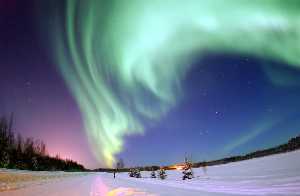© 2007 All Rights Reserved. Do not distribute or repurpose this work without written permission from the copyright holder(s).
Printed from https://danginteresting.com/the-sound-of-the-aurora/
Herein lie the first Dang Interesting words of our most recent writer, Richard Solensky.

If you happen to be reasonably close to one of the Earth’s magnetic poles, the next time there’s a particularly intense aurora, go outside. Get as far as you can from sources of noise – traffic, barking dogs, TVs – and listen. Listen carefully.
If conditions are right, you may hear some unusual noises. Earwitnesses have said the sound is like radio static, a small animal rustling through dry grass and leaves, or the crinkling of a cellophane wrapper. Inuit folklore says it’s the sound of the spirits of the dead, either playing a game or trying to communicate with the living.
It’s the sound of the aurora itself. And the cause is currently unknown. Understanding the phenomenon is made more difficult by the fact that though there are many anecdotal reports, the sound has yet to be recorded.
Aurora displays are caused by the solar wind interacting with the Earth’s magnetic field and atmosphere. Because these interactions happen at altitudes of at least sixty kilometers, the sounds heard cannot be made by the aurora directly. Even if the air up there were dense enough to support sound waves, they would disperse and fade long before they reached the ground.
The sounds aren’t common, and there doesn’t seem to be any consistency in their occurrences. What’s more, one observer of an aurora may hear the sounds distinctly, while another observer of the same display— even at the same location— may not.
The inconsistency makes it difficult to determine the underlying cause of the sounds. As with any faint phenomenon that is difficult to observe and study, theories abound. One hypothesis claims it’s all in the observer’s head. Modern media has made us used to hearing sound along with visual display, so we sometimes believe we are hearing things even when there is no actual sound. But this doesn’t account for those Inuit legends that predate the technological era, nor does it account for observations made by blindfolded or indoor observers.
Another theory also claims it’s all in your head, but for a different reason. Electrophonic hearing is the direct stimulation of the auditory nerves by external electromagnetic fields. There are reports of people hearing “clicks” and “pops” coincident with lightning flashes, and well ahead of any thunder, that can only be explained this way. The theory is unable to explain why only the sense of hearing is affected – though there are rare reports of people noting odd smells accompanying an aurora display.
The sounds could also be due to what is known as brush discharge. According to this theory, the ionization effects that produce the aurora are technically reaching ground level, but the intensity at low altitudes is not strong enough to produce a visible display. This causes a buildup of static electricity on nearby objects, which intermittently discharges into the atmosphere. In effect, this produces microscopic bolts of lightning. If this theory is correct, the sound the observer is hearing is the result of thousands of these tiny sparks. The effect would be strongest on long, thin, dry objects such as grass or frizzy hair, which are best at bleeding off excess charge.
Of all the hypotheses, the most likely suspect, since it can be duplicated in the lab, is electrophonic transduction. Certain very low frequency radio waves have the same frequency as sound waves. Long, thin conductors – grass, hair, wire eyeglass frames – serve as antennae for these radio waves. When these antennae receive the signal, they vibrate and transform the radio energy directly into sound.
VLF radio waves have been detected in aurora displays, and have been found to be produced by meteors as well. It is worth noting that sounds similar to those associated with aurora have been heard in conjunction with meteors, and even recorded.
Electrophonic transduction is similar to the cases where dental work turns people’s mouths into radio receivers. That phenomenon is believed to be the result of fillings or braces acting as a crude crystal radio, which can pick up AM signals when close to a strong source. A person’s body acts as the antenna, and the combination of saliva and metal fillings can behave like a diode to “rectify”- or demodulate – a strong AM signal. A loose filling or bridgework can act as a small speaker, and the sound is carried to the ear through bone conduction. Rusty pipes have also been heard to function as radio receivers in this fashion. Electrophonic transduction is different from this phenomenon in that it does not involve rectifying or demodulation.

But there’s still no firm consensus as to whether the sounds of the aurora are the product of very low frequency radio waves, electromagnetic stimulation, or over-active imaginations.
So the next time there’s a nice display in your area, go outside. Get as far away from everything else as you can. Look up, and listen.
You might just hear something inexplicable.
And the Northern Lights in the crystal nights came forth with a mystic gleam.
They danced and they danced the devil-dance over the naked snow;
And soft they rolled like a tide upshoaled with a ceaseless ebb and flow.
They rippled green with a wondrous sheen, they fluttered out like a fan;
They spread with a blaze of rose-pink rays never yet seen of man.
They writhed like a brood of angry snakes, hissing and sulphur pale…
—Robert W. Service, “The Ballad of the Northern Lights”
© 2007 All Rights Reserved. Do not distribute or repurpose this work without written permission from the copyright holder(s).
Printed from https://danginteresting.com/the-sound-of-the-aurora/
Since you enjoyed our work enough to print it out, and read it clear to the end, would you consider donating a few dollars at https://danginteresting.com/donate ?